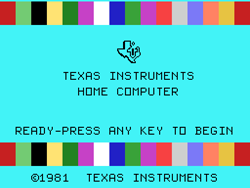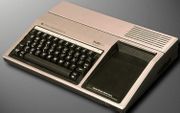In 1982, my father took me to a coworkers home to examine an electronic device called the TI-99/4A home computer. The coworker was a reseller of these systems and Dad was interested in purchasing one. I recall going down into the tan and brown decor finished basement of the man’s home, complete with wood paneling and no windows. In another room, that served as an office, the man had the computer setup on a desk with a monitor and several other peripheral devices. The computer itself was an attractive, compact, low-profile keyboard case made of brushed steel and black plastic.
 We watched as the man demonstrated the machine. He moved a slider switch on the front corner and a red light came on. The screen flickered and seconds later, there was a blocky image of the TI logo against a blue background with rainbow patterns in horizontal stripes on the top and bottom. The screen read: TEXAS INSTRUMENTS HOME COMPUTER
We watched as the man demonstrated the machine. He moved a slider switch on the front corner and a red light came on. The screen flickered and seconds later, there was a blocky image of the TI logo against a blue background with rainbow patterns in horizontal stripes on the top and bottom. The screen read: TEXAS INSTRUMENTS HOME COMPUTER
READY-PRESS ANY KEY TO BEGIN.
The man pressed the space bar on the keyboard, and then the computer gave a simple menu with one option: “TI Basic.” When he clicked it, we saw what I would later recognize as a “command prompt” appeared on the bottom right of an otherwise blank blue screen.
He explained some things to my father, and then proceeded to insert a black cartridge into the right side of the keyboard. The screen suddenly went dark, and then the words TI-INVADERS appeared on the screen, along with blocky moving aliens dancing across the screen. I was familiar with Space Invaders from the ATARI 2600 systems that were prevalence in most homes of the day, but we could immediately recognize the superior graphics of this version. He proceeded to hit a button on the keyboard, and then using a small joystick, move and shoot the attacking aliens.
I was so excited that I practically peed in my pants. My Dad seemed mildly impressed. The man continued to load other games, and even perhaps a few rudimentary financial applications. After talking for a time that seemed like hours, my dad asking questions and likely negotiating price, we finally left without a computer in hand.
 Some time later, Dad would come home with a large box. I immediately recognized the TI logo and jumped for joy. We took the box downstairs, carefully removed the Styrofoam packaging, and laid out all the parts. It came with the main computer assembled, power cord, and an RF adapter for use with our existing TV set, a couple of blue bound paperback manuals, one entitled TI-BASIC. The computer also came with the complimentary game “TI Invaders.”
Some time later, Dad would come home with a large box. I immediately recognized the TI logo and jumped for joy. We took the box downstairs, carefully removed the Styrofoam packaging, and laid out all the parts. It came with the main computer assembled, power cord, and an RF adapter for use with our existing TV set, a couple of blue bound paperback manuals, one entitled TI-BASIC. The computer also came with the complimentary game “TI Invaders.”
That evening we stayed up late, playing the Space Invaders knockoff, playing in two player mode, and then competing in single player. We would make this a nightly ritual for a few more weeks before the game got boring. Dad and I looked at the manuals and we read the introduction to TI-BASIC. We typed:
PRINT “HELLO ERN!”
Then hit enter. The screen showed:
HELLO ERN!
We messed around with that some more, but it wasn’t incredibly exciting. We ordered a few more game cartridges, including a ridiculous Pac-Man knockoff called munch man. Otherwise, Dad had better things to do with his time. He probably considered it a bad investment. Given the state of the art at the time, I don’t blame him. Many people viewed that first “boom” in the computer market as a novelty. The machines were only useful to bored kids and the true geeks of the day.
That summer, with a lack of interest in the 2 or three miserable games we had purchased and way too much time on my hands, I began to read more about TI-BASIC. I discovered that information could be saved using a “string” based on user input and then compared to other variables using a conditional statement. Using this rudimentary principle, I spent interminable hours writing question-based games. Little did I know, there was already a substantial body of such games being produced as the ZORK series, dating back to the late 70’s. The computer nerds of the day considered ZORK some of the best games available, and are still a lot of fun to play. Being very small and all text based, they have been ported to most handheld devices at the time of this writing.
The terrible problem with the TI was that we had purchased the central processor, but there was no writeable media. I remember being forced to keep the computer on to save my programs that I had spent hours on, and then being outraged if there was a power outage, or my parents turned it off. The entire system was moved into my bedroom for use with my new 10″ black & white TV set so I could leave it on without my parents knowing it.
I eventually found the solution to my problem in a TI promotional catalog. There was a special cable that allowed you to load and save data into the computer from a standard cassette recorder, which I had gotten for Christmas from my grandmother a few years before. I begged and begged, and finally got the adapter in the mail.
It came with a manual that was probably a bit too complex for my 3rd grade mind, but I did figure out that my cassette machine lacked the required 8″ pause/cue jack necessary for the computer to control the device. I labored for days, even weeks to get it to work to no avail. I even recall considering stealing one from a neighbors house that I saw one day and hiding it from my parents. Every time I see an old desktop cassette machine, I look still look for that damn cue jack.
Finally, I discovered a method of timing the machine from the beginning of the tape after consulting with a high school student up the road. I was then able to save! It often didn’t work, though, and was very frustrating. I spent days writing a very long interactive program that I let my mom and dad play, even using basic to render primitive images. It only took them about 5 minutes to complete the final version.
It was my first lesson on the labors of programming with slow fingers.
Most of my other friends and most US school systems had acquired the famed APPLE II series by 83-84, which loaded data from 5 inch floppy drives, and remained the standard for the computing world as late as 1990. With two drives, people were able to copy games and data, and I immediately understood the beauty of illegal digital bootlegging.
TI had lost millions on the 99/4A in a price war with Commodore and Apple, having to sell the superior hardware of the TI at a loss. They left the personal computer business permanently in 83. Problems with the RF adapter and the cartridge contacts sent mine into the closet for good.
Realizing the uselessness of my computer, I lost interest in programming until I moved to Kingsport. My new friend Ben Roosevelt had an APPLE II and a vast collection of disk based strategy games that I found to be mind-blowing at the time: ZORK series, Ultima, and many more historic titles. On my request, and thanks to a mutual interest in logic, we also spent a lot of time eating refined sugar and working with APPLE basic, which despite minor syntactic differences, was pretty much the same. But we could save to disk. Wow.
My family wouldn’t own another significant computer until the 90’s, and I was generally more interested in girls and music by then anyway. I worked as an assistant in our high school computer lab in 92-93, and my experience came in handy on the DOS-based PC’s running WordPerfect.
It wouldn’t be until 1998 that I would buy my own PC, telnet into my university’s UNIX system, and discover the decades of mainframe, usenet, networked architecture that I missed due to ignorance and lack of peer influence. It was only a matter of months before I was speaking Bash, writing HTML in emacs, and only a year before I started teaching myself PERL for web.
But that is another story.
j0shua
Ahh. This version of history sounds like a close parallel to my own experience, except that I had a C-64, which had a four part SID synthesizer. The first programs I wrote were rudimentary music bleeps and bloops, copied from the user manual and then trying out random values to create different sounds.
We eventually also picked up the 1541 disk drive which allowed me to save my programs as well. I had been leaving the computer on for weeks on end as well, i even remember covering the power LED so that they wouldnt know it was still on.
And ahh the joy of programming text adventure games. I spent the majority of my 3rd (?) grade afternoons in a dark basement working on my master adventure game on a monochrome apple II-c.
And, just like Ern, I lost interest around high school, choosing to devote my time to skateboarding, girls, and music.
It was not until college and the purchase of a 486 that I realized how much technology had passed me by, in those few years. I have retroactively picked much of it in order to keep pace with current PC tech, but I’m sure my knowledge would have been much more comprehensive had I stuck with it all along.
hindsight is 20/20, or so they say….